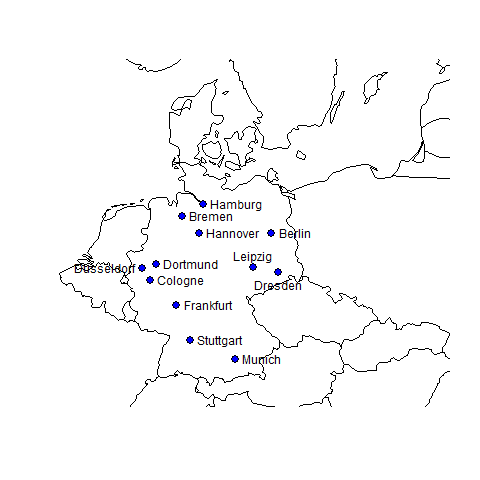Motivation
A widespread belief among people skeptical about the necessity of ambitious climate change mitigation is that global warming will lead to net decreases in the temperature-related death burden, at least in temperate regions. The underlying argumentation is that while more frequent and more intense heat waves will undeniably bring about more heat-related mortality, this increased death burden might be overcompensated by concomitant declines in cold-related mortality. Checking the validity of this argumentation, based on death count statistics and weather station data from Germany, was the main motivation behind our peer-reviewed scientific article: “Temperature-related excess mortality in German cities at 2 °C and higher degrees of global warming”, published in Environmental Research. Let’s recapitulate here what the epidemiological evidence from Germany tells us about the climate-skeptics’ claim on alleged health benefits to be expected from climate change. But before we dive into the results from the paper, we will first explain how temperature-related mortality is actually “measured”.
Temperature attributable death burden in the current climate
Once the statistical temperature-mortality associations are established the next step in the analysis consists of computing the number and fractions of total deaths that can be attributed to the exposure of non-optimal temperatures. In these computations one compares the factual risk with a hypothetical situation, in which the population is constantly exposed to the optimal temperature and thus experiences minimal risk. Therefore, the attributable mortality is also referred to as excess mortality. In our paper, we found that in the study period considered (1993-2015) exposure to low and high ambient temperatures was associated with 5.49% and 0.81%, respectively, of the total number of deaths observed in the 12 major German cities studied (cf., squares and whiskers in first panel of Fig. 4). This translates into approximately 56 cold-related and 8 heat-related annual excess deaths per 100 000 population averaged across all cities. To put these numbers in context, e.g., the heat-attributable mortality rate is about twice the mortality rate due to traffic accidents in Germany (based on data for 2015). Thus, already in the current climate, cold and heat-related mortality represents a significant public health risk that administrative bodies should not take lightly.
Show data for

Total (black), cold-related (blue) and heat-related (red) excess mortality for all cities combined (first panel) and by city. Squares depict excess mortality estimates based on observational data over 1993-2015. Circles show mean excess mortality averaged across climate model runs, for 1°C to 5°C increases in global mean temperature (ΔGMT) above pre-industrial levels. Whiskers and shading show uncertainty ranges (95% confidence intervals), taking into account uncertainty related to temperature-mortality associations and climate projections.
FIG 4
Regarding the relatively greater death burden attributable to cold than attributable to heat, Germany shows the same pattern as most locations examined in recent global studies including hundreds of locations around the world. It is however important to note that, if only the extremes of the temperature distribution are considered, cold and heat tend to contribute more equally to total temperature attributable mortality. As can be seen in Fig. 2 a great part of the cold attributable mortality stems from the fact that populations are exposed to moderate temperatures, which are associated with small relative risks by themselves, but which occur on many days of the year. And the fact that cold (defined as in our paper) is associated with a greater death burden than heat in the current climate, does of course not allow to draw any conclusions on the net changes to be expected under future climate change.
Mortality projections at different levels of global warming
We will see now how future mortality changes were addressed in our paper, taking into account the uncertainty inherent in simulations of future temperature trajectories, in accordance with four climate-change scenarios, from four global climate models. The approach taken in our paper was to estimate cold- and heat-related mortality for different levels of global mean temperature rise (above pre-industrial levels). We chose this approach, contrary to the more common method of showing results for selected scenarios and future time periods, in order to judge results in the light of common climate policy objectives, such as holding global warming below 2°C. To compute future excess mortality, we simply combined the estimated exposure-response functions (Fig. 2) with projected daily temperature from the global climate models, averaging results across 20-year time windows representative of the considered global warming levels. All of our results are, therefore, based on the assumption that the demography does not change and that no adaptation measures are taken in the future. Thus, our estimates are best interpreted as exposing the current population of Germany's major cities, embedded in current infrastructures and health care systems, to different possible temperature distributions of the future.
Show data for

Differences in excess mortality compared to today’s 1 °C of global warming for all cities combined (first panel) and by city. Bars and circles correspond to averages across climate model runs for each level of global warming considered (cf. Fig. 4). Whiskers show uncertainty range (95% confidence intervals) in net differences.
FIG 5
Under this assumption we find for all cities, as expected, an increase in heat-related mortality and a decline in cold-related mortality along the levels of global warming considered (1°C to 5°C increase in global temperatures above pre-industrial levels) (Fig. 4). As an example, for the strong warming scenario of 4°C we find that 4.06% of total death occurring in all cities are attributable to heat, corresponding to a 5-fold increase in heat-related mortality compared to the current situation. On the other hand, cold attributable mortality only constitutes 3.61% of total death at this high level of global warming, corresponding to a 30% decline in the attributable fraction compared to today. Overall, for higher levels of global mean temperature rise (>3°C) our findings suggest a reversal of the current cold- versus heat attribution pattern, with heat attributable mortality potentially exceeding cold attributable mortality in the future (Fig. 4).
At this point of the analysis, we can finally turn to assessing the climate skeptics claim on net decreases in temperature-related mortality posed in the beginning. For global warming >2°C our results indicate net increases in total temperature-related mortality to be expected in the majority of the German cities considered, providing clear counter-evidence to the claim (Fig. 5) The only exceptions are the two coastal cities, Bremen and Hamburg, with generally cooler summers, where slight (yet insignificant) net decreases in mortality are estimated for global warming levels 2°C and 3°C (Fig. 5). It is interesting to note that due to their geographical location both cities were spared from the extreme temperatures occurring in some of the other cities during the 1994, 2003, and 2006 summer heat waves represented in our dataset. Thus, it is possible that the temperature-mortality associations underlying our projections underestimate the future heat attributable death burden in these two cities, putting into question even the slight net decline in total temperature-related mortality found in our analysis. Our results for Germany are in accordance with previous studies of greater geographical coverage, which did project net declines in temperature-related excess mortality for a number of locations, but which overall concluded on the risk of significant increases in net temperature-attributable mortality, especially in the poorest and most populated countries of lower latitudes.
Conclusions
Contrary to the assertion sometimes brought forward by climate skeptics, our study suggested that there are no substantial net benefits in terms of saved lives to be expected from climate change in Germany. The only clear benefits suggested by the paper are those from reducing emissions in order to keep global warming below 2°C, as set out by the Paris Agreement. According to our findings, limiting warming to 2°C compared to 3°C and higher degrees of global mean temperature rise, conceivable by the end of the century, would avoid potential net increases in overall temperature-related mortality in Germany and, in particular, would save the German society from facing stark increases in heat-related excess mortality. To prepare for the impacts of unavoidable climate change, adaptation measures, such as improving heat health warning systems, devising urban cooling centres, greening cities, and integrating cooling systems into buildings, are indispensable.
Affiliations
1 IBE Chair of Epidemiology, LMU Munich, Germany
2 Potsdam Institute for Climate Impact Research (PIK), Member of the Leibniz Association, P.O. Box 60 12 03, D-14412 Potsdam, Germany
